From Dog Hobble To Spring Snowflake – 35 Bell-Shaped Flowers You Might Not Recognise

Reviewed By ROY NICOL

Roy is a Professional Gardener and Horticultural Consultant, specialising in large garden year-round maintenance and garden development. He is an RHS Master of Horticulture and uses his research in the application of no-dig methods in ornamental garden settings. Roy has been a Professional Gardener for more than six years and is a member of the Chartered Institute of Horticulture, Professional Gardener's Guild and Association of Professional Landscapers (Professional Gardener).
IN THIS GUIDE
- 1) Trumpet Vine
- 2) Coral Bells
- 3) Lantern Tree
- 4) Daffodil
- 5) Morning Glory
- 6) Grape Hyacinth
- 7) Mountain Laurel
- 8) Lily Of The Valley
- 9) Bells Of Ireland
- 10) Peach-Leaved Bellflower
- 11) Persian Lily
- 12) Mini Angel’s Trumpet
- 13) Bellflower Beardtongue
- 14) Bluebells
- 15) Cowberry
- 16) Allium Tripedale
- 17) Foxglove
- 18) Dog Hobble
- 19) Common Morning Glory
- 20) Desert Rose
- 21) Trumpet Honeysuckle
- 22) Canterbury Bells
- 23) Bog Laurel
- 24) Spanish Bluebell
- 25) Small-Leaved Fuchsia
- 26) Balloon Flower
- 27) Spring Snowflake
- 28) Giant Bellflower
- 29) Penstemon ‘Windsor Red’
- 30) Austrian Clematis
- 31) Digitalis ‘Temple Bells’
- 32) Lily ‘Casa Blanca’
- 33) Twin Flower
- 34) Snake’s Head Fritillary
- 35) Columbine
- References
Bell-shaped flowers are beloved by pollinators and can provide beautiful interest to your garden displays.
In this guide, I’ll share 35 of the best plants that produce bell-shaped blooms throughout all seasons – so you can find a variety that is best suited to you and your garden, no matter the time of year.
1) Trumpet Vine

- BOTANICAL NAME: Campsis radicans
- COMMON NAME(S): trumpet vine / trumpet climber
- HARDINESS RATING: H4
- PLANT TYPE: climber / shrub
- FOLIAGE TYPE: deciduous
- FLOWERS: red and orange
- FLOWERING SEASON(S): summer / autumn
This climbing deciduous shrub is a great way to kick off this list.
Producing beautiful bell-shaped flowers in shades of orange and red in the summer and autumn, this plant can grow up to 12m in height.
Trumpet vine looks great when grown at the back of a garden bed against a wall or trellis.
“It is best grown against a south-facing wall to capture the most warmth and sun possible,” shares Roy Nicol, a Master Horticulturist.
“This is also when it will flower at its best and have protection from the coldest winter weather.”
2) Coral Bells

- BOTANICAL NAME: Heuchera sanguinea
- COMMON NAME(S): coral bells / fairy flower
- HARDINESS RATING: H6
- PLANT TYPE: perennial
- FOLIAGE TYPE: semi-evergreen
- FLOWERS: red
- FLOWERING SEASON(S): summer
Coral bells are popular in UK gardens and produce small red flowers from thick stems throughout the summer.
Although they prefer a neutral soil pH, they are relatively unfussy plants and can grow in most locations.
“They grow best in a partial shade position which doesn’t dry out too much, although darker leaved varieties will grow in sunnier positions, where their colours are enhanced,” says Roy.
These easy-to-grow perennials look great when planted next to hostas or ferns, providing a colourful burst of colour against their understated foliage.
3) Lantern Tree

- BOTANICAL NAME: Crinodendron hookerianum
- COMMON NAME(S): Chilean lantern tree / lantern tree
- HARDINESS RATING: H4
- PLANT TYPE: shrub
- FOLIAGE TYPE: evergreen
- FLOWERS: red
- FLOWERING SEASON(S): spring / summer
The Chilean lantern tree is actually a large shrub that has suffered a decline in popularity in UK gardens due to the fact it can grow up to a whopping 8m in height.
However, if you have the space, I would definitely recommend growing this evergreen delight.
This unusual plant bears red, neat-looking, bell-shaped flowers that grow in clusters that hang individually on long stems.
Try growing Crinodendron hookerianum as a hedge or at the back of a garden for privacy.
It has a preference for moist, acidic soils and would need some protection in the coldest winters.
This plant holds the RHS Award of Garden Merit, meaning it has been shown to grow reliably in gardens.
4) Daffodil

- BOTANICAL NAME: Narcissus pseudonarcissus
- COMMON NAME(S): wild daffodil / bell rose / averill
- HARDINESS RATING: H6
- PLANT TYPE: bulb
- FOLIAGE TYPE: deciduous
- FLOWERS: yellow, orange and white
- FLOWERING SEASON(S): spring
Daffodils are a cottage garden classic, and with their orange, bell-shaped centres and yellow, star-shaped outer petals, it’s easy to see why.
Not only do they look great, but daffodils are also super easy to grow and are a great place to start if you are new to gardening.
“Wild daffodils also self-seed freely over time, so it’s best not to deadhead these plants as you would with other daffodils if you’d like them to spread,” adds Roy.
5) Morning Glory
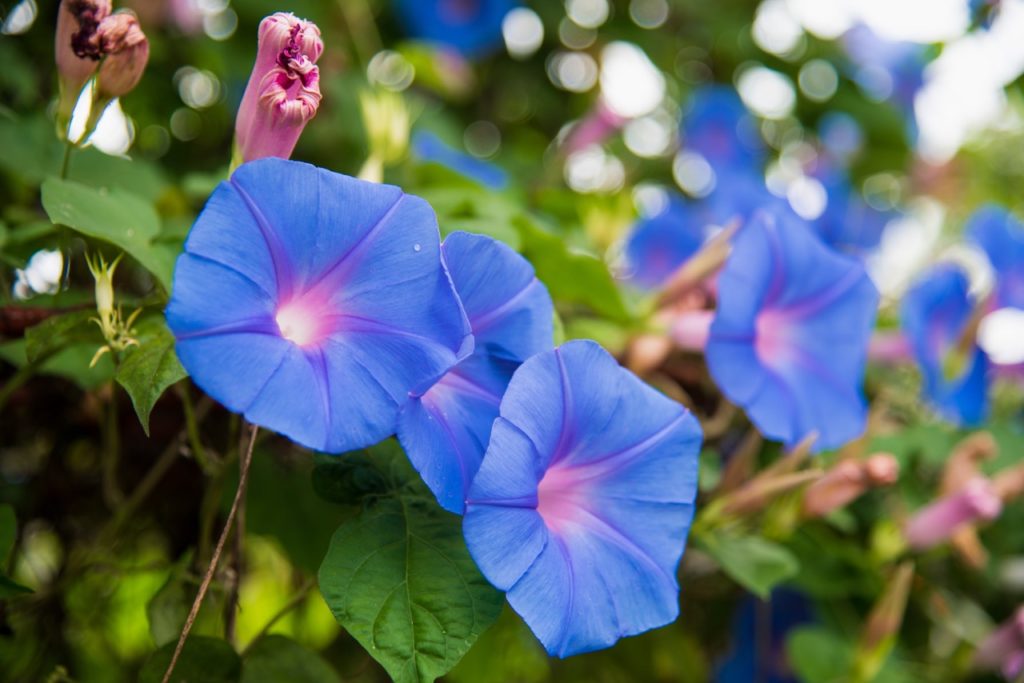
- BOTANICAL NAME: Ipomoea tricolor
- COMMON NAME(S): morning glory
- HARDINESS RATING: H1C
- PLANT TYPE: annual / climber / shrub
- FOLIAGE TYPE: deciduous
- FLOWERS: purple, blue and white
- FLOWERING SEASON(S): summer
Ipomoea tricolor, also known as morning glory, is a deciduous climber that is most commonly grown as an annual in the UK, as it is frost-tender and cannot survive winters outside.
This shrub produces blue bell-shaped flowers that are streaked with white at the centre, on long stems that grow alongside green heart-shaped leaves.
Morning glory can grow up to 4m in height, making it perfect for the back of a border or for growing against a trellis.
I also think it looks great when staked and grown in a pot, which is the best chance you have of keeping it in flower for longer, as you can move it inside on colder days.
6) Grape Hyacinth

- BOTANICAL NAME: Muscari
- COMMON NAME(S): common grape hyacinth / grape flower
- HARDINESS RATING: H6
- PLANT TYPE: bulb
- FOLIAGE TYPE: deciduous
- FLOWERS: blue, white and black
- FLOWERING SEASON(S): spring
Producing tiny, blue bell-flowers in clusters at the top of long, thick stems, the grape hyacinth famously gained its name for producing flowers that resemble the fruit of grapes.
Another popular choice for the English cottage garden, this beloved deciduous bulb sprouts from the ground in autumn and its arching green leaves provide interest over the winter months before the flowers emerge in spring.
Some varieties of Muscari will readily self-seed around the garden, so if you prefer to keep them contained, remember to deadhead the flowers to prevent the seed from spreading.
7) Mountain Laurel
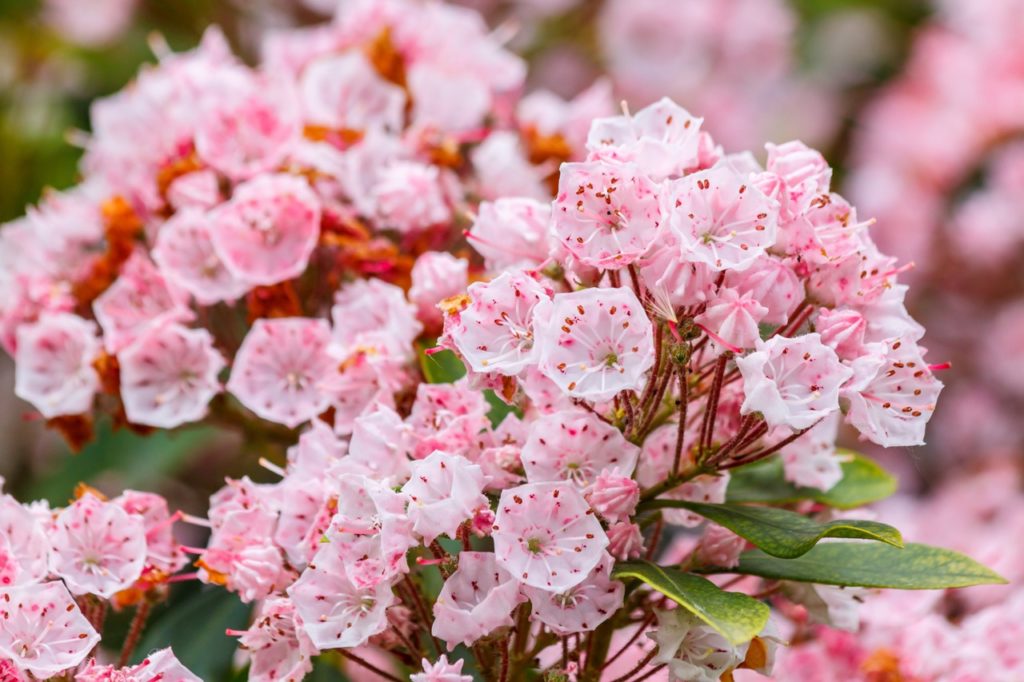
- BOTANICAL NAME: Kalmia latifolia
- COMMON NAME(S): mountain laurel
- HARDINESS RATING: H6
- PLANT TYPE: shrub
- FOLIAGE TYPE: evergreen
- FLOWERS: pink
- FLOWERING SEASON(S): spring / summer
This medium-sized evergreen shrub produces clusters of pink bell-shaped flowers that stand out against the plant’s dark green foliage.
A relatively unfussy plant, Kalmia latifolia is popular with UK gardeners due to the fact that it requires little care once planted out.
Mountain laurel would work great for hedging or at the back of a border if grown somewhere where the soil is slightly acidic.
8) Lily Of The Valley

- BOTANICAL NAME: Convallaria majalis
- COMMON NAME(S): lily of the valley / conval lily / lady’s tears
- HARDINESS RATING: H7
- PLANT TYPE: perennial
- FOLIAGE TYPE: deciduous
- FLOWERS: white
- FLOWERING SEASON(S): spring
The lily of the valley plant is popular in British gardens but is more commonly found in woodland areas.
This fragrant flower produces small, white bell-shaped flowers in the summer that hang like lanterns from the tall stem they grow from – a beautiful addition to any garden.
9) Bells Of Ireland
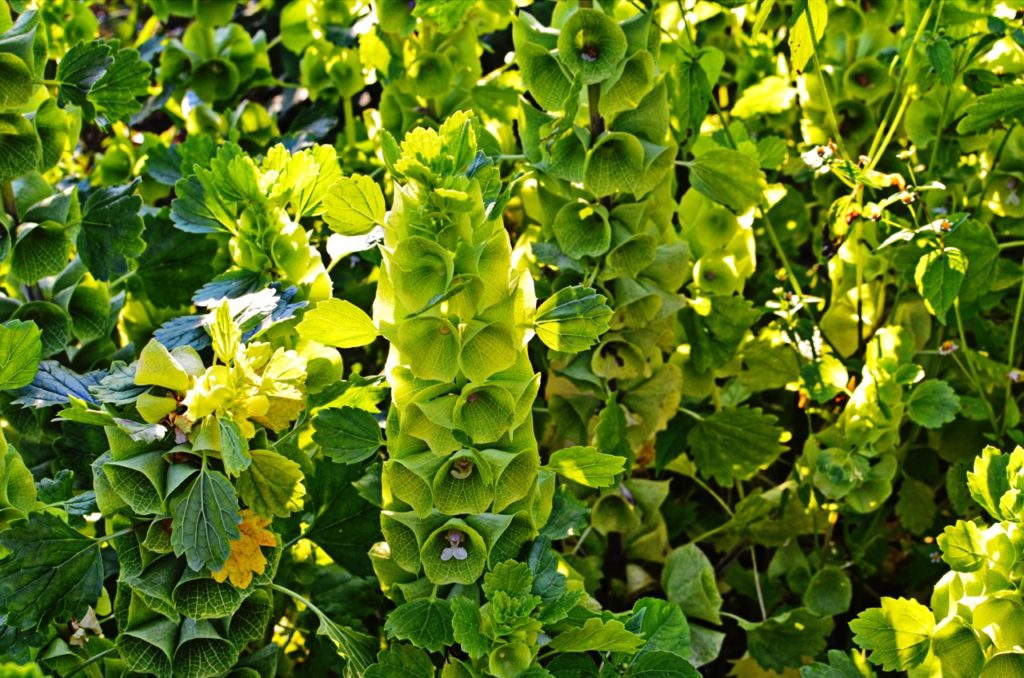
- BOTANICAL NAME: Moluccella laevis
- COMMON NAME(S): bells of Ireland / Irish bell flower
- HARDINESS RATING: H4
- PLANT TYPE: annual
- FOLIAGE TYPE: deciduous
- FLOWERS: white and green
- FLOWERING SEASON(S): summer
This unique plant has lots of green bells adorning its tall stems that produce white flowers in the summer months.
Not only does Moluccella laevis provide interest when planted in garden displays, it also has aromatic qualities and should be grown somewhere where you can enjoy the beautiful aroma it produces when flowering.
This hardy plant, which is often grown as an annual in the UK, also looks great as a cut flower and can be added to many beautiful bouquets.1Bells of Ireland. (n.d.). BBC Gardening. Retrieved March 22, 2023, from https://www.bbc.co.uk/gardening/plants/plant_finder/plant_pages/2813.shtml
10) Peach-Leaved Bellflower

- BOTANICAL NAME: Campanula persicifolia
- COMMON NAME(S): peach-leaved bellflower / fairy bells
- HARDINESS RATING: H7
- PLANT TYPE: perennial
- FOLIAGE TYPE: evergreen
- FLOWERS: blue and purple
- FLOWERING SEASON(S): summer
A popular upright perennial that produces blue bell-shaped flowers from tall green stems, the peach-leaved bellflower makes a lovely addition to any garden.
With lots of campanula varieties to choose from, this is one of my favourites, as its purply-blue petals always look beautiful wherever they are grown.
This plant prefers alkaline soil and would be great in a mixed perennial bed where you want foliage that lasts from season to season.
11) Persian Lily

- BOTANICAL NAME: Fritillaria arabica
- COMMON NAME(S): Persian lily
- HARDINESS RATING: H4
- PLANT TYPE: perennial bulb
- FOLIAGE TYPE: deciduous
- FLOWERS: green / brown / purple
- FLOWERING SEASON(S): spring
Producing beautiful dark flowers along a thick, upright stem in the springtime, the Persian lily is a great choice if you want something a little more dramatic.
It requires little maintenance once planted outdoors as long as it receives full sun and can even be grown as a houseplant for those who want to add an exotic flare to their homes.
Keep an eye on its green leaves for another treat; they are sometimes tinged with stunning silver in the warmer months.
12) Mini Angel’s Trumpet
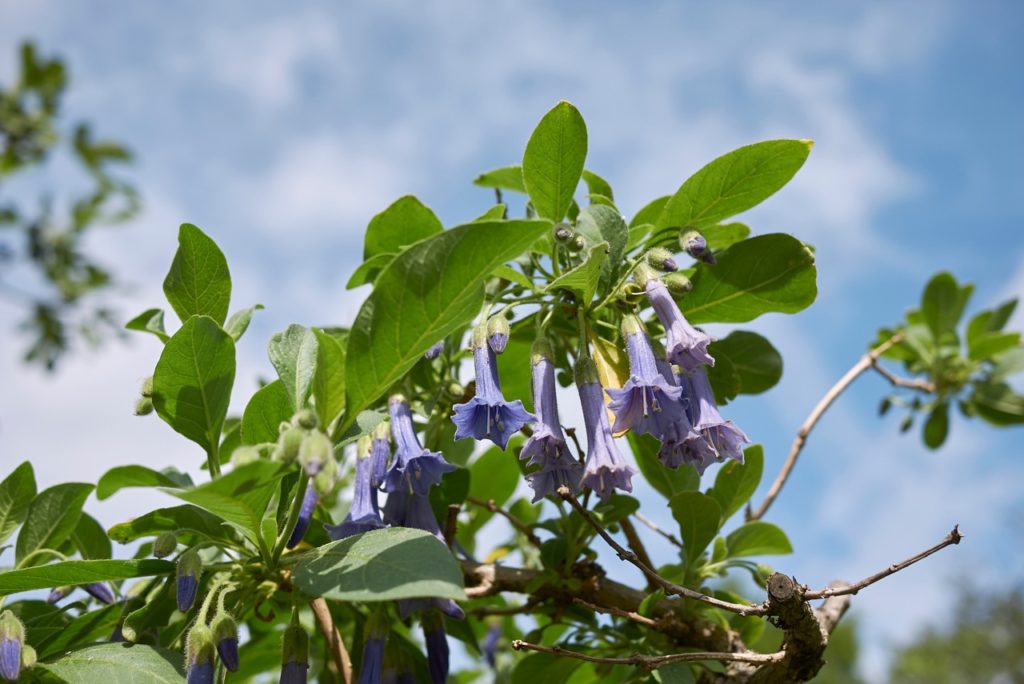
- BOTANICAL NAME: Eriolarynx australis
- COMMON NAME(S): mini angel’s trumpet
- HARDINESS RATING: H3
- PLANT TYPE: shrub / tree
- FOLIAGE TYPE: semi-evergreen
- FLOWERS: blue and purple
- FLOWERING SEASON(S): summer
Eriolarynx australis is a half-hardy tree or shrub that produces small lavender bell-shaped flowers and ruffled green leaves that can be evergreen if grown in a greenhouse or another warmer location.
Native to South America, this plant is a great choice for pollinators, producing a gorgeous aroma that is more noticeable in the evenings as the pollen is released.2Olorunshola, Y. (n.d.). Why do plants smell? Kew Royal Botanic Gardens. Retrieved March 22, 2023, from https://www.kew.org/read-and-watch/why-do-plants-smell
13) Bellflower Beardtongue

- BOTANICAL NAME: Penstemon campanulatus
- COMMON NAME(S): bellflower beardtongue
- HARDINESS RATING: H4
- PLANT TYPE: perennial
- FOLIAGE TYPE: semi-evergreen
- FLOWERS: purple, red and white
- FLOWERING SEASON(S): summer
Another great pollinator, with its flowers attracting bees, butterflies and even hummingbirds, the bellflower beardtongue is a great choice for those wanting to create a wildlife garden.
This beautiful perennial produces stunning flowers in shades of deep purple to creamy white and would look great in a mixed border with other perennial flowers – or in a rock garden to add a touch of colour.
14) Bluebells

- BOTANICAL NAME: Hyacinthoides non-scripta
- COMMON NAME(S): bluebell / bell bottle
- HARDINESS RATING: H6
- PLANT TYPE: bulbs
- FOLIAGE TYPE: deciduous
- FLOWERS: blue and white
- FLOWERING SEASON(S): spring
Bluebells are a cottage garden classic and are often seen in woodland areas growing in the shaded spots underneath trees.
As their name suggests, they produce dainty bell-shaped blue flowers on upright stems that often droop at the top, creating a whimsical arching effect.
Before growing bluebells, it’s important to note that these are prolific self-seeders, so if you don’t want your garden to be overrun by these bulbous plants, then it might be a good idea to opt for another on this list.
15) Cowberry
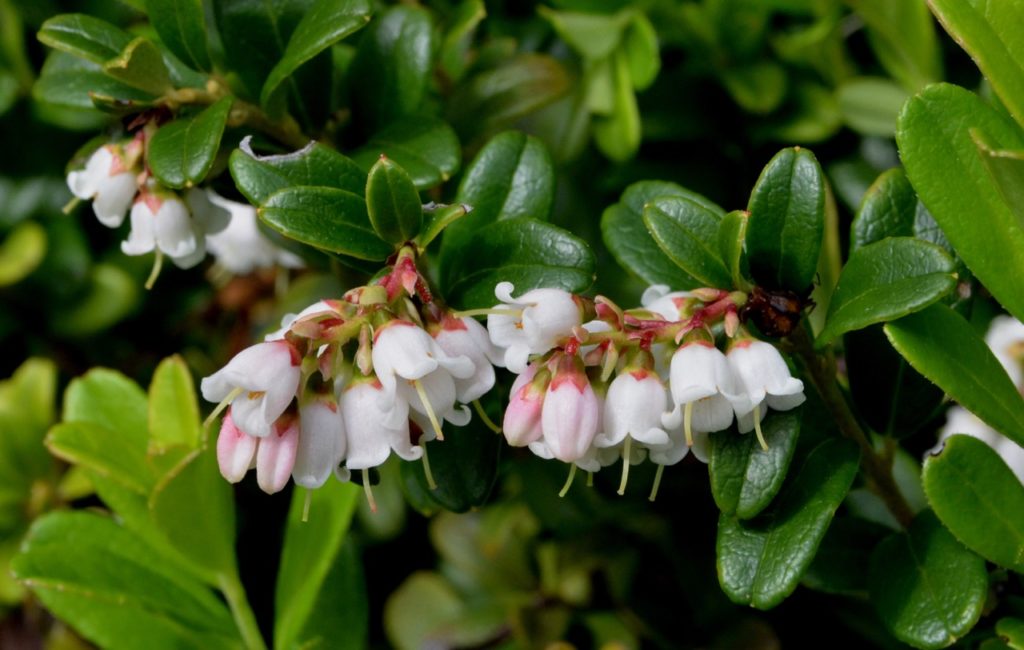
- BOTANICAL NAME: Vaccinium vitis-idaea
- COMMON NAME(S): cowberry
- HARDINESS RATING: H6
- PLANT TYPE: fruit / shrub
- FOLIAGE TYPE: evergreen
- FLOWERS: white
- FLOWERING SEASON(S): summer
This beautiful white-flowering shrub has a creeping habit and can reach a spread of up to 1.5m, producing small, dark green foliage that has a waxy finish.
After flowering, you can enjoy the round, glossy red fruits that the cowberry produces.
These are edible, however, they are rarely consumed here in the UK, but if you’re feeling bold, you can add them to jellies, jam or other preserves.
16) Allium Tripedale
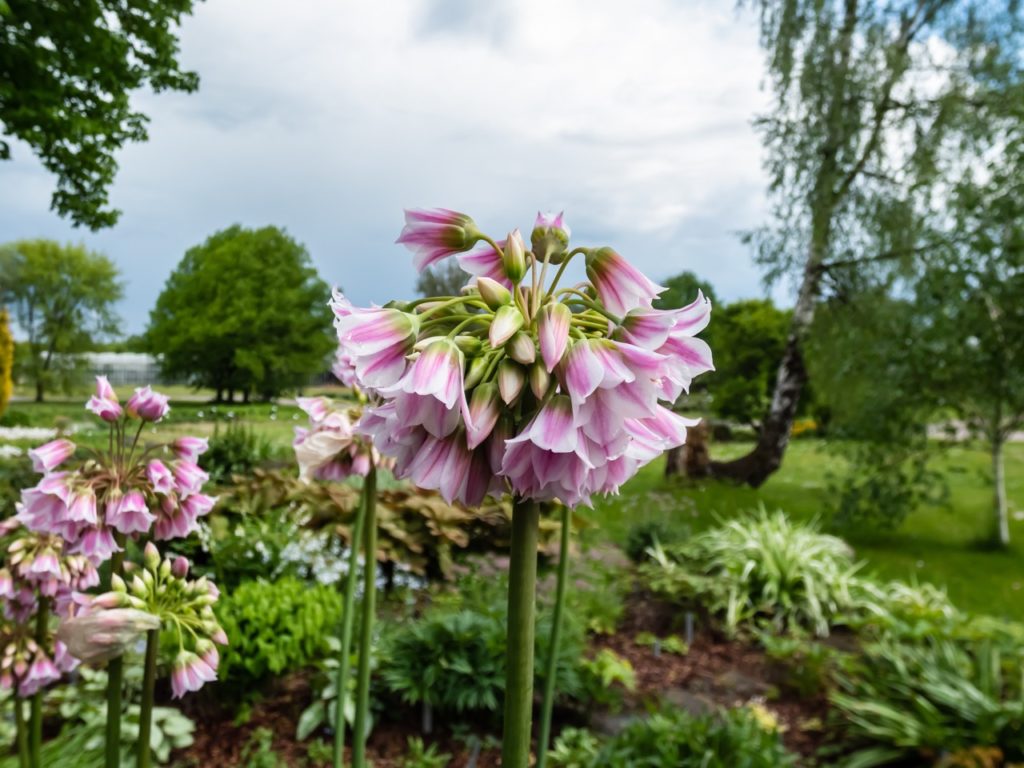
- BOTANICAL NAME: Allium tripedale
- COMMON NAME(S): Allium tripedale
- HARDINESS RATING: H4
- PLANT TYPE: bulb
- FOLIAGE TYPE: deciduous
- FLOWERS: white
- FLOWERING SEASON(S): summer
With thick stems growing as tall as 1m, Allium tripedale is a unique-looking plant that has fragrant leaves that have a garlicky aroma.
The flowers are beautiful, with white petals that are streaked with a pale pink growing in clusters at the top of the tall stems throughout the summer months.
17) Foxglove

- BOTANICAL NAME: Digitalis purpurea
- COMMON NAME(S): common foxglove / bloody bells
- HARDINESS RATING: H7
- PLANT TYPE: annual
- FOLIAGE TYPE: deciduous
- FLOWERS: purple
- FLOWERING SEASON(S): summer
Foxgloves are one of the most obvious choices that come to mind when thinking about plants with bell-shaped flowers.
They look great in natural planting schemes or as part of a most sophisticated cottage garden theme but will need replacing each year as they tend to only live for a short-period.
Despite this, I think their beautiful purple flowers that grow on tall stems are definitely worth the effort and added time.
18) Dog Hobble

- BOTANICAL NAME: Leucothoe fontanesiana
- COMMON NAME(S): dog hobble
- HARDINESS RATING: H6
- PLANT TYPE: shrub / drooping laurel
- FOLIAGE TYPE: evergreen
- FLOWERS: white
- FLOWERING SEASON(S): spring
Dog hobble is a stunning evergreen shrub that produces arching branches that are decorated with an abundance of small, white bell-shaped flowers throughout spring.
This plant can look great growing at the back of a border and can even be used for hedging or garden screening.
19) Common Morning Glory
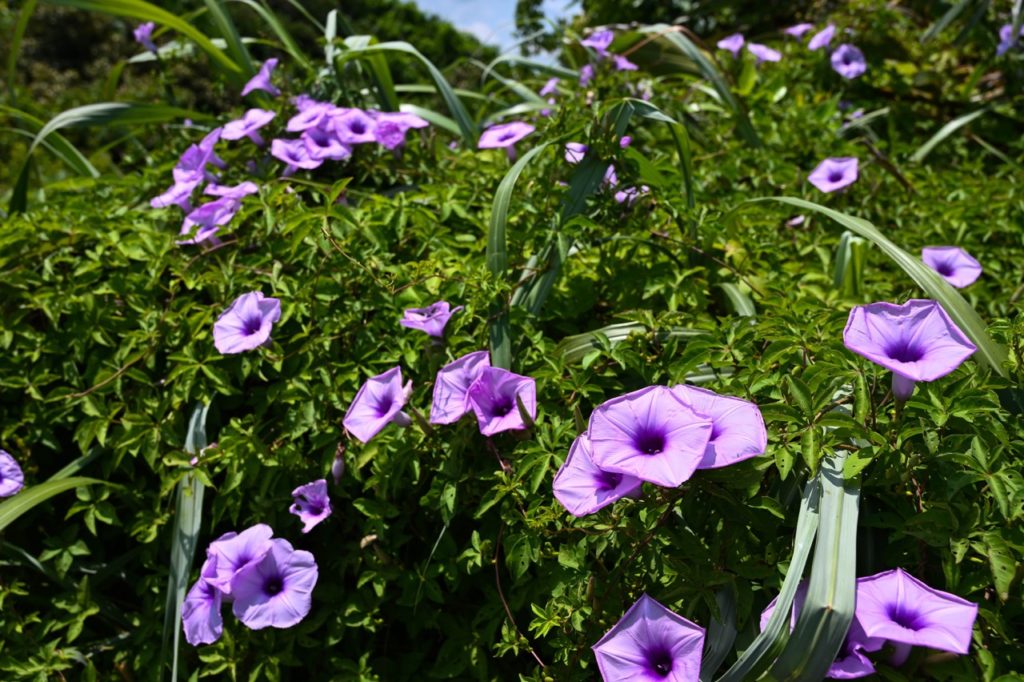
- BOTANICAL NAME: Ipomea purpurea
- COMMON NAME(S): common morning glory
- HARDINESS RATING: H1C
- PLANT TYPE: annual / climber / shrub
- FOLIAGE TYPE: deciduous
- FLOWERS: blue, purple, red and white
- FLOWERING SEASON(S): summer / autumn
The morning glory plant is such a delight that I couldn’t resist sharing another variety on this list.
Ipomea purpurea mainly produces – you guessed it – purple flowers, but it can also come in shades of blue, red and white, which can be paired together to make a beautiful display throughout the summer and autumn months.
20) Desert Rose

- BOTANICAL NAME: Adenium obesum
- COMMON NAME(S): desert rose
- HARDINESS RATING: H1A
- PLANT TYPE: cacti / succulent
- FOLIAGE TYPE: deciduous
- FLOWERS: red, pink and white
- FLOWERING SEASON(S): summer
The flowers of the desert rose plant are truly a sight to behold.
Creamy bell-shaped flowers that are striped with shades of pink and red growing from thick, woody branches appear throughout the summer months.
Due to its hardiness, this plant, which is technically a succulent, is most commonly grown as a houseplant in the UK and cannot survive even a hint of cold if planted outdoors.
So, if you’re looking for a unique bell-shaped cactus to grow in your home, this is definitely a bold choice.
21) Trumpet Honeysuckle

- BOTANICAL NAME: Lonicera sempervirens
- COMMON NAME(S): trumpet honeysuckle / coral honeysuckle
- HARDINESS RATING: H5
- PLANT TYPE: climber / shrub
- FOLIAGE TYPE: evergreen
- FLOWERS: yellow / orange / red
- FLOWERING SEASON(S): spring / summer / autumn
Honeysuckle is beloved by many gardeners and this bell-shaped variety is no exception.
Producing fiery flowers in shades of red and yellow, this climbing shrub can reach up to 4m in height, making it a great choice for the back of a border.
22) Canterbury Bells

- BOTANICAL NAME: Campanula medium
- COMMON NAME(S): Canterbury bell
- HARDINESS RATING: H4
- PLANT TYPE: annual
- FOLIAGE TYPE: deciduous
- FLOWERS: blue, pink and white
- FLOWERING SEASON(S): summer
Canterbury bells are often incorporated into cottage garden schemes and are known for their large bell-shaped flowers that usually appear in bright shades of purple, pink, blue and white.
These beautiful flowers are mainly grown as annuals in the UK, but can also be planted as a biennial if placed in the right growing conditions – something that this plant is not too fussy about.
23) Bog Laurel
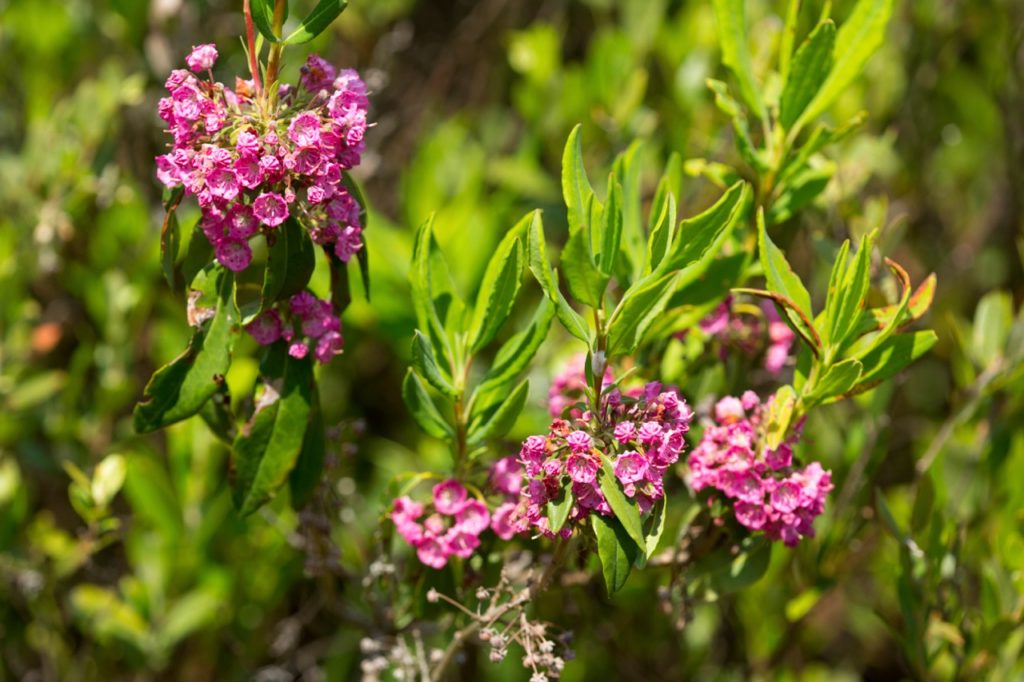
- BOTANICAL NAME: Kalmia polifolia
- COMMON NAME(S): bog kalmia / bog laurel
- HARDINESS RATING: H5
- PLANT TYPE: shrub
- FOLIAGE TYPE: evergreen
- FLOWERS: pink and purple
- FLOWERING SEASON(S): spring
Another variety of kalmia that has made it to the list, the bog laurel produces flowers that are slightly smaller and darker in colour than their mountain counterpart.
Either way, it still has a beautiful presence, with its beautiful pink and purple blooms appearing in springtime to brighten up your displays.
24) Spanish Bluebell

- BOTANICAL NAME: Hyacinthoides hispanica
- COMMON NAME(S): Spanish bluebell / large bluebell
- HARDINESS RATING: H6
- PLANT TYPE: bulb
- FOLIAGE TYPE: deciduous
- FLOWERS: blue or pink
- FLOWERING SEASON(S): spring
A shade-loving plant, this bulbous plant will grow in most conditions in the UK and is fully hardy, meaning it can withstand even the harshest of winter conditions.
As mentioned above, bluebells can self-seed readily, so keep that in mind when adding the Spanish bluebell to your garden schemes.
25) Small-Leaved Fuchsia
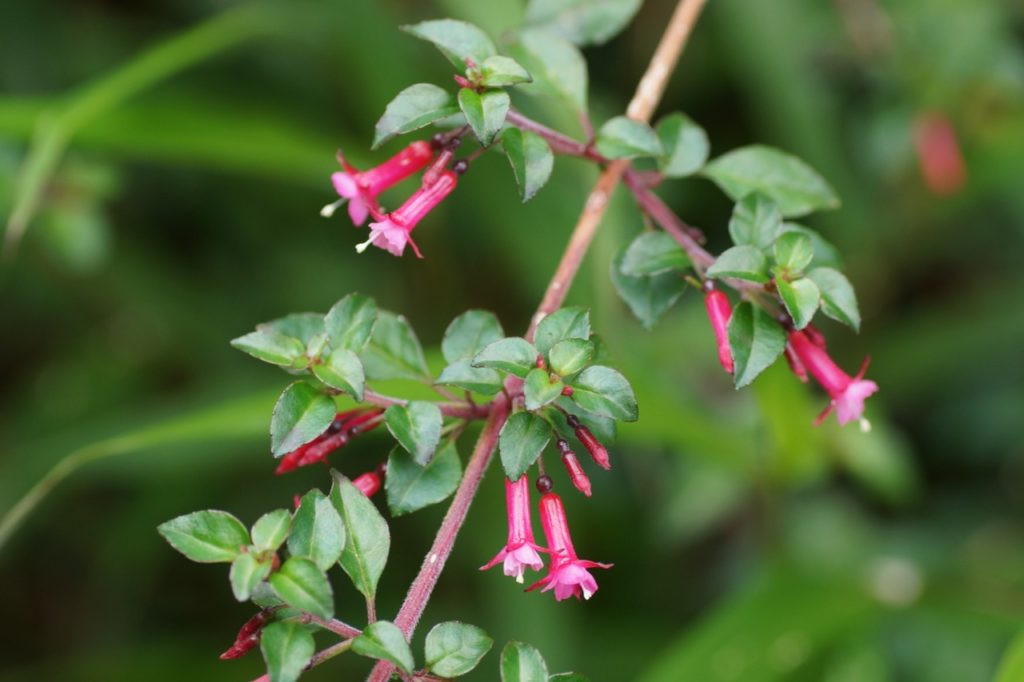
- BOTANICAL NAME: Fuchsia microphylla
- COMMON NAME(S): small-leaved fuchsia
- HARDINESS RATING: H3
- PLANT TYPE: shrub
- FOLIAGE TYPE: semi-evergreen
- FLOWERS: pink, red and white
- FLOWERING SEASON(S): summer
Fuchsias produce unmistakable flowers with the sepals and petals often providing a contrast in colour, and the small-leaved fuchsia is no exception.
As its name suggests, this shrub produces tiny green leaves that are sometimes tinged with red, but the flowers are also rather tiny, with deep pink sepals that peel away to reveal pink petals with white centres.
These bell-shaped beauties would make a lovely addition to any garden display, whether you make use of their ornamental value by growing them in a garden bed, or opt for a more practical option and grow them as a hedge or a back-of-the-garden shrub.
26) Balloon Flower

- BOTANICAL NAME: Platycodon grandiflorus
- COMMON NAME(S): balloon flower
- HARDINESS RATING: H5
- PLANT TYPE: perennial
- FOLIAGE TYPE: deciduous
- FLOWERS: blue
- FLOWERING SEASON(S): summer / autumn
With large flowers that are often layered, the balloon flower is a member of the Bellflower family and can produce gorgeous blooms in its first year of planting.
This herbaceous perennial is a unique plant that is suitable for growth in UK gardens, having received the RHS Award of Garden Merit.
27) Spring Snowflake

- BOTANICAL NAME: Leucojum vernum
- COMMON NAME(S): spring snowflake / Agnes flower
- HARDINESS RATING: H5
- PLANT TYPE: bulbs
- FOLIAGE TYPE: deciduous
- FLOWERS: green and white
- FLOWERING SEASON(S): spring
Leucojum vernum, more commonly known as the spring snowflake, is a gorgeous spring-flowering bulb that produces dreamy white bell-shaped flowers that are tinged with lime green at their tips.
The stems have an arching form and the thin leaves are dark green and have a glossy finish.
These beautiful flowering plants would look great in a meadow scheme, a cottage garden, a border or in a rockery.
28) Giant Bellflower

- BOTANICAL NAME: Campanula macrantha
- COMMON NAME(S): giant bellflower
- HARDINESS RATING: H7
- PLANT TYPE: perennial
- FOLIAGE TYPE: deciduous
- FLOWERS: purple and blue
- FLOWERING SEASON(S): summer
A fully hardy plant, the giant bellflower is easy to grow and care for, producing distinctive purply-blue bell-shaped flowers that can grow up to 5cm long during the summer months.
The flowers grow on upright stems that can grow to over 1m and are beloved by pollinators – perfect for a wildlife-friendly garden.
29) Penstemon ‘Windsor Red’

- BOTANICAL NAME: Penstemon ‘Windsor Red’
- COMMON NAME(S): penstemon ‘windsor red’
- HARDINESS RATING: H5
- PLANT TYPE: perennial
- FOLIAGE TYPE: semi-evergreen
- FLOWERS: red
- FLOWERING SEASON(S): summer / autumn
I couldn’t resist adding this beautiful penstemon cultivar to this list.
‘Windsor red’ is a semi-evergreen perennial that produces beautiful bright red flowers that are streaked with flecks of white on the inside of their petals.
They are fairly unfussy plants and can make a great addition to various planting schemes and gardens.
30) Austrian Clematis

- BOTANICAL NAME: Clematis alpina
- COMMON NAME(S): Austrian clematis
- HARDINESS RATING: H6
- PLANT TYPE: climber / shrub
- FOLIAGE TYPE: deciduous
- FLOWERS: blue and cream
- FLOWERING SEASON(S): spring
The flowers from the Austrian clematis shrub stand out from any other on this list.
They are made up of 4 frilly sepals that surround a creamy-green stamen to produce a bell-shaped effect.
These fascinating flowers bloom in the springtime and grow from green or red drooping stems that also bear green rigid leaves.
31) Digitalis ‘Temple Bells’

- BOTANICAL NAME: Digitalis ‘Temple Bells’
- COMMON NAME(S): Digitalis ‘Temple Bells’
- HARDINESS RATING: H5
- PLANT TYPE: perennial
- FOLIAGE TYPE: semi-evergreen
- FLOWERS: yellow
- FLOWERING SEASON(S): spring
Digitalis ‘Temple Bells’ is a yellow-flowering variety of foxglove that makes a beautiful addition to any springtime perennial bed or woodland plant schemes.
The bell-shaped flowers grow from thick green stems that can grow up to 1m in height.
32) Lily ‘Casa Blanca’
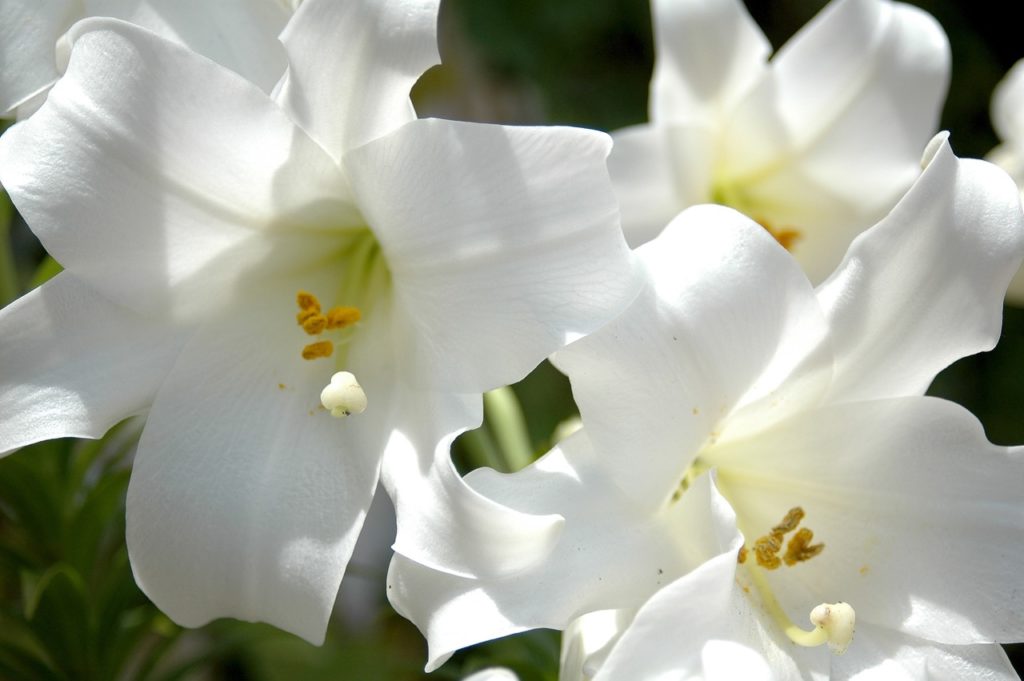
- BOTANICAL NAME: Lilium ‘Casa Blanca’
- COMMON NAME(S): lily ‘Casa Blanca’
- HARDINESS RATING: H6
- PLANT TYPE: bulb
- FOLIAGE TYPE: deciduous
- FLOWERS: white
- FLOWERING SEASON(S): summer
There are many varieties of lily that could be on this list, but the large, pure-white flowers that bloom in summer from the ‘Casa Blanca’ cultivar are too beautiful to resist.
‘Casa Blanca’ is fully hardy and relatively easy to grow as long as it is grown in a sheltered location in acidic soil.
You could grow these plants in borders or beds, containers, or even use them in cut flower displays in your home.
33) Twin Flower

- BOTANICAL NAME: Linnaea borealis
- COMMON NAME(S): twin flower / cinnamon vine
- HARDINESS RATING: H6
- PLANT TYPE: shrub
- FOLIAGE TYPE: evergreen
- FLOWERS: pink
- FLOWERING SEASON(S): summer
The twin flower is a small shrub with oval, glossy green leaves and pale pink drooping flowers that are produced in bells from V-shaped stems.
Growing up to only 10cm in height with a 1m spread, this evergreen shrub is ideal for ground cover and would grow well for underplanting other flowers in a rock garden display.
34) Snake’s Head Fritillary

- BOTANICAL NAME: Fritillaria meleagris
- COMMON NAME(S): Snake’s Head Fritillary
- HARDINESS RATING: H5
- PLANT TYPE: bulb
- FOLIAGE TYPE: deciduous
- FLOWERS: pink and purple
- FLOWERING SEASON(S): spring
No doubt my favourite on the list, this stunning bulbous plant produces large pink and purple bell-shaped flowers that cover the petals in a checkerboard manner.
The arching stems of Snake’s Head Fritillary, no doubt named after the scaly skin of snakes that mirror its flowers, are reminiscent of bluebells and would look great in a garden bed filled with other drooping bell-shaped flowers.
Unfortunately, numbers of this fascinating plant have declined due to a decrease in the number of meadows here in the UK – but once planted, it is easy enough to grow, so there is no excuse for not incorporating Fritillaria meleagris into your planting schemes.3Tatarenko, I. V., Walker, K., & Dyson, M. L. (2022). Biological Flora of Britain and Ireland: Fritillaria meleagris. Journal of Ecology, 110(7), 1704–1726. https://doi.org/10.1111/1365-2745.13886
35) Columbine

- BOTANICAL NAME: Aquilegia vulgaris
- COMMON NAME(S): common columbine / American bluebells
- HARDINESS RATING: H7
- PLANT TYPE: perennial
- FOLIAGE TYPE: deicduous
- FLOWERS: purple and blue
- FLOWERING SEASON(S): spring / summer
My final pick is another cottage garden classic.
The American bluebell produces dainty flowers from thin stems throughout the spring and summer in various shades of purple and blue and is a great choice for garden borders or beds.
A fully hardy perennial, columbine is relatively low-maintenance once planted and will provide a touch of colour to your planting schemes year after year if placed in the right location.
References
- 1Bells of Ireland. (n.d.). BBC Gardening. Retrieved March 22, 2023, from https://www.bbc.co.uk/gardening/plants/plant_finder/plant_pages/2813.shtml
- 2Olorunshola, Y. (n.d.). Why do plants smell? Kew Royal Botanic Gardens. Retrieved March 22, 2023, from https://www.kew.org/read-and-watch/why-do-plants-smell
- 3Tatarenko, I. V., Walker, K., & Dyson, M. L. (2022). Biological Flora of Britain and Ireland: Fritillaria meleagris. Journal of Ecology, 110(7), 1704–1726. https://doi.org/10.1111/1365-2745.13886

